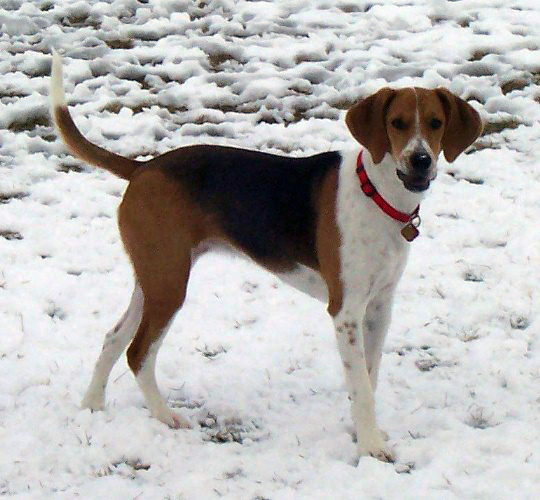- Harrier (dog)
:"This article is about the dog. For other uses, see
Harrier (disambiguation)."Infobox Dogbreed
name= Harrier
image_caption= A tri-color Harrier
altname=
nickname=
country=United Kingdom
fcigroup= 6
fcisection= 1
fcinum= 295
fcistd= http://www.dogdomain.com/fcistandards/fci-295.htm
akcgroup= Hound
akcstd= http://www.akc.org/breeds/harrier/index.cfm
ankcgroup= Group 4 (Hounds)
ankcstd=http://www.ankc.aust.com/harrier.html
ckcgroup= Group 2 (Hounds)
ckcstd= http://www.ckc.ca/en/Default.aspx?tabid=99&BreedCode=HRI
kcukgroup=
kcukstd=
nzkcgroup=Hound
nzkcstd= http://www.nzkc.org.nz/br472.html
ukcgroup =Scenthound
ukcstd = http://mail.ukcdogs.com/UKCweb.nsf/80de88211ee3f2dc8525703f004ccb1e/aba031cc00ea9b6b8525704c00623476?OpenDocument|The Harrier is a small to medium sized
dog breed of thehound class, used for hunting hares by trailing them. It resembles anEnglish Foxhound but is smaller, though not as small as aBeagle .Description
Appearance
The Harrier is similar to the English Foxhound, but smaller. They are one of the few truly medium-sized breeds of dogs. Harriers stand between 19 and 21 inches at the shoulder, and adults weigh between 45 and 60 lbs. They have short hair, hanging ears, and come in a variety of color patterns. A humorous, yet fairly accurate short-hand description of a Harrier is that of "a
Beagle on steroids." It is a muscular hunting hound with a short, hard coat. It has large bones for stamina and strength. The Harrier is slightly longer than tall, with a level topline. The tail is medium-length, carried high, but is not curled over the back. The skull is broad with a strong square muzzle. The rounded ears are pendant, and the eyes are either brown or hazel. The wide nose is black. The expression is mellow when the dog is relaxed and alert when he is excited. The teeth should meet in a scissors or level bite. The feet are tight and cat-like, and the front toes may turn inward.Temperament
The Harrier is cheerful, sweet-tempered, tolerant, and it is excellent with children. This pack dog is good with other dogs, but should be supervised with noncanine pets unless it is raised with them from puppyhood. It prefers life in a pack with people, dogs, or both. This active dog likes to go exploring, sniffing, and trailing, so be sure to keep it on a leash or in a safe enclosed area. Some Harriers like to bay.
Health
This breed's lifespan is generally 10-12 years. Hip dysplasia is known to occur in this breed.
Care
Exercise
The Harrier requires daily exercise, such as long vigorous walks or runs. Allowing them to play in open space (so long as it is enclosed and safe) makes exercise fun and easy. Without appropriate exercise, the Harrier can become hyperactive, overweight and/or destructive. This dog was bred to run and work all day long and cannot be satisfied by a sedentary lifestyle.
History
Sources have widely conflicting stories about the origins of this breed. According to one, the earliest Harrier types were crossed with
Bloodhound s, the Talbot Hound, and even theBasset Hound . According to another, the breed was probably developed from crosses of theEnglish Foxhound withFox Terrier andGreyhound . And yet another, the Harrier is said to be simply a bred-down version of the English Foxhound. The first Harrier pack in England was established by Sir Elias de Midhope in 1260 and spread out as a hunting dog throughout the west of England and into Wales. Although there are many working Harriers in England the breed is still not recognised in that country.In any case, today's Harrier is between the
Beagle and English Foxhound in size and was developed primarily to hunt hares, though the breed has also been used in fox hunting. The name, Harrier, reveals the breed's specialty. The Harrier is still fairly rare in the United States, but has a long history of popularity as a working pack dog in England.References
External links
* [http://www.harrierclubofamerica.com/ Harrier Club of America]
*http://www.downhomeharriers.com/facts.html
*http://www.ridgecrest.ca.us/~auborn/harriers/harrier_info.html
Wikimedia Foundation. 2010.
